Did you know that AI-powered waterjet cutting is redefining Brazil's custom furniture industry at an unprecedented pace? This revolutionary approach is not just transforming how we craft high-end pieces but also enhancing sustainability like never before.
As Brazil's artful furniture craftsmanship seeks to merge with cutting-edge technology, AI integrations in waterjet machinery could be more essential now than ever. The urgency? This trend prepares us for a sustainable, tailored future in furniture design.
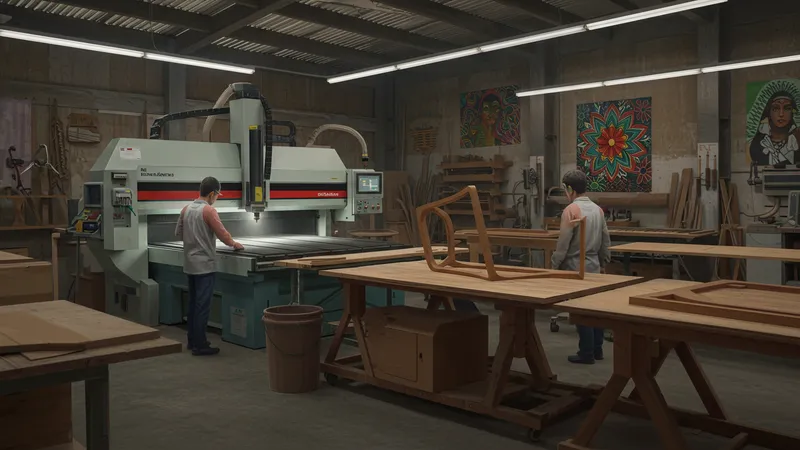
Imagine a world where every distinctive curve of your furniture is crafted with millimetric precision, made possible through AI-driven waterjets. A technology that was once a fantasy among only the most futuristic thinkers is now in our hands. Yet, AI isn't just about precision. It's about revolutionizing production processes, reducing waste, and optimizing resources like nothing before. But that’s not even the wildest part...
As designers in Brazil tap into this powerful technology, they're witnessing a shift from traditional artisan methods to modern, sustainable practices. These AI-powered waterjets don't just cut—they predict and adapt, elevating the very essence of craftsmanship. The fusion of artistry and technology is carving a new path for the industry, but here’s the twist: the boom is setting off a chain reaction of innovation and competition, making waves that only an insider could foresee. What happens next shocked even the experts…
AI-powered waterjet technology doesn't just ensure precision; it fosters an unprecedented reduction in material waste. By harnessing algorithms that predict the optimal cuts, manufacturers are significantly minimizing surplus. This approach aligns seamlessly with eco-conscious consumer demands, fostering a new appreciation for sustainable furniture design. Yet, the surprising impact is that it also slashes costs for businesses, pushing traditional furniture makers to reconsider their methods. But there’s one more twist...

The technology's impact extends beyond the cutting floor. It enhances designers' creativity by allowing them to experiment with complex shapes and forms previously deemed impossible. The ability to innovate without constraint encourages a creativity boom within the industry. What was once a tedious manual task now becomes an artistic exploration, broadening the horizons of every creative mind involved. And that's just the beginning of its influence—what you read next might change how you see craftsmanship forever.
Brazil's market is no stranger to rich artisan traditions, yet the integration of AI in waterjet cutting is raising eyebrows across the nation. Established manufacturers and up-and-coming brands alike are now compelled to integrate this technology or risk falling behind. It’s a game-changer, blending tradition with modern efficiency in a seamless dance that’s redefining success. But what about the hidden challenges they face?
As the trend catches on, the race in adopting AI tools is intensifying. Companies dash to embrace these innovations, while skilled labor adapts to a new norm, marking a surprising shift in job roles. The challenge lies in balancing mastery with mechanical efficiency—a feat requiring not just skill but strategy. These changes tell a story of transition that paints a vivid contrast to the past, stirring both excitement and skepticism. And this shift? Only deepens as we delve deeper...
For Brazil's artisans, the advent of AI-driven waterjet technology means a rapid transformation of craftsmanship. Far from replacing the artisan's skill, it acts as an enhancement, allowing for a precision that was once only a dream. The AI learns and grows with each task, meaning that what artisans now need isn’t just hands-on experience, but technological fluency. The artisan of the future might soon be more technician than traditional craftsman. But that’s merely scratching the surface...
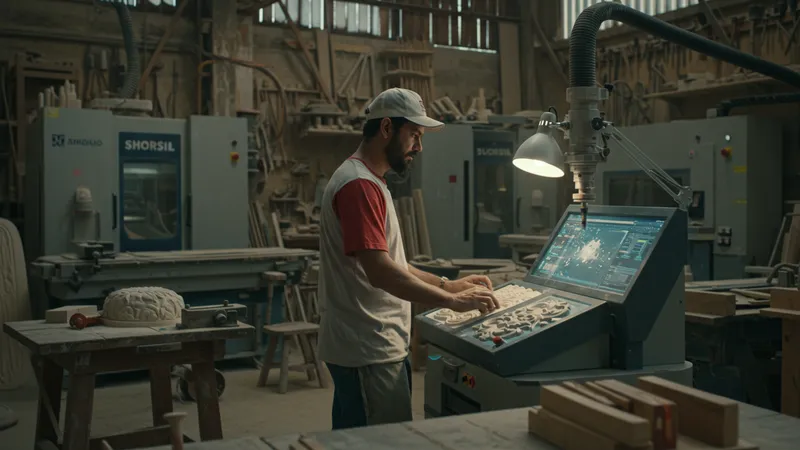
As these technologies make their way into workshops, artisans face the challenge of merging their intuitive, artistic instincts with the calculative precision of machines. This collaboration is rewriting the narrative of manual crafting. Artisans are finding a new voice as they become fluent in digital design and execution, leading to a new wave of creativity. Yet adjusting to this digital influx can be daunting, creating a constant balance between tradition and technology.
The newfound synergy between human creativity and machine precision fosters an unimaginable hybrid of knowledge and skill. With AI learning from every project, the tools become sharper, more efficient, and scarily accurate. This synergy not only streamlines production but also spurs innovations that challenge the market status quo. What comes next could potentially elevate artisans to unprecedented levels of skill and renown. But the question remains: can the culture evolve quickly enough?
Meanwhile, market expectations are shifting. Consumer curiosity is being piqued, driving demand for designs that challenge the norms. This opens unexpected doors for local artisans to showcase their skills on international platforms, transforming Brazil’s local genius into a global conversation. Amid this sea of change lies an undercurrent of cultural recalibration that is steering the industry into uncharted waters. The stakes are higher than ever... what’s waiting just around the corner?
Brazil’s furniture industry, with its lush history of vibrant designs and rich textures, finds itself at a crossroads. Local markets are adapting, albeit slowly, to the tremendous potential AI-powered waterjet cutting brings. However, global demand beckons with lucrative opportunities, forcing local artisans and manufacturers to rethink export strategies. Why? Because tapping into AI not only fine-tunes artistry but also aligns with global sustainability practices, becoming a selling point in itself. But brace yourself...
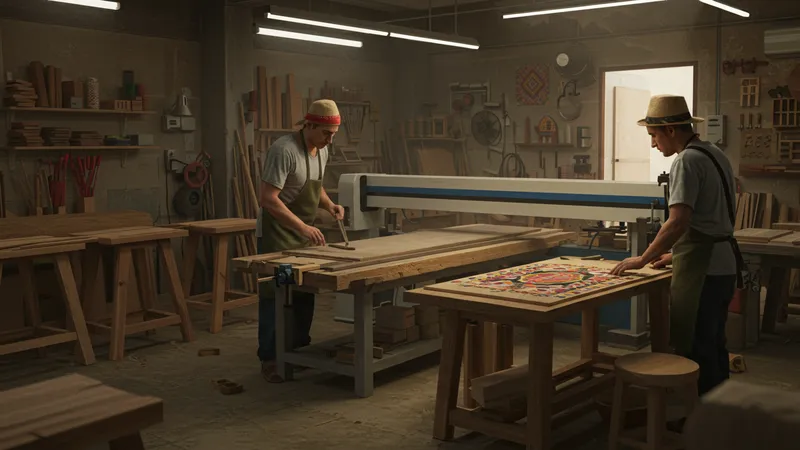
This collision of local tradition with international standards is nudging designs into the global spotlight. The prospect of reaching international markets is tantalizing for Brazilian artisans who’ve been crafting in the shadow of global giants. AI technology affords them precision and resilience, creating pieces that meet international quality benchmarks while maintaining distinct local flair. Yet, balancing this with authenticity remains the tightrope they must walk.
The benefits extend to logistics, where predictive tools streamline production timelines, ensuring that Brazilian fixtures arrive trustfully to international buyers. Amid all these transformations, there’s an undeniable sense of urgency—adopting these technologies isn’t just a matter of innovation but survival. The industry is evolving into a living testament of how tradition and technology can coexist. Yet, amidst the advancement, a question looms: who truly holds the reins of this transformation?
Globally, the narrative shifts. Technology narrows the disparity between developed and emerging markets, equalizing playing fields like never before. With these seismic shifts, Brazil's path forward isn’t just a journey into AI innovation—it’s a definitive step into global leadership in custom furniture design. As AI continues to reach into every crevice of the trade, the boundaries are yet to be fully explored. Next comes a revelation that could redefine the very essence of artistry...
Despite the dazzling possibilities AI brings to custom furniture, there’s an elephant in the room: the environmental impact. Waterjet cutting requires significant water usage, and in a country where environmental consciousness is increasing, it’s a sensitive topic. However, AI-powered systems are evolving to better manage this crucial resource, promoting sustainable practices that align with Brazil's wider ecological goals. This creates a dual benefit—enhancing production while preserving the environment.

AI-integrated systems optimize water usage through intelligent recycling processes, cutting down on waste. They can predict exact amounts necessary for cuts, thus minimizing environmental footprint and aligning with green certifications. Manufacturers are starting to leverage these greener methods, not just as compliance but as brand differentiators, appealing to eco-conscious consumers around the world. Yet, this is only the surface, uncovering a more profound environmental story.
As sustainability becomes central to consumer choices, companies must address the rate of resource consumption. AI technology not only aids in eco-friendly production but also assists consumers in making informed choices. Products can now come with a full story—from raw material sourcing to the finished piece—allowing customers to opt for more sustainable options. This transparency encourages competition, pushing the industry toward more sustainable practices faster than before. But what about the next challenge?
There’s an unspoken urgency in balancing industrial progress with preservation. AI-powered waterjet machines are at the forefront, yet they encounter inevitable environmental criticisms. As demand for sustainably produced goods increases, manufacturers are under pressure to innovate further. The next stages of this diversity require creative problem-solving and a comprehensive commitment to sustainability practices. The climate of this evolution suggests a response that is yet evolving... unraveling into a narrative that promises more than meets the eye.
The ascent of AI technology in waterjet cutting invites a shift in the employment landscape. Traditional roles are transforming, leaning heavily on technology skills rather than hands-on crafting prowess. The introduction of automated systems raises crucial questions about the future positions within the industry. Will this spark a massive upskilling initiative, or will it lead to an inevitable reduction in artisan roles? It’s a turning point demanding attention.

In response, educational programs focused on equipping artisans with necessary technological skills are gaining momentum. Emphasizing computer-aided design (CAD) skills, programming for precision machinery, and innovative thinking around AI applications is crucial. This evolution not only secures current jobs but also creates new roles attracting a younger, tech-savvy workforce eager to redefine artistry in the digital era. The workforce's transformation, however, brings new dynamics to address.
As traditional craftspeople collaborate with tech-driven methods, the emotional aspect of human creativity meets mechanical precision. This blend fosters an invigorating landscape of opportunity where innovation isn't merely encouraged—it’s unavoidable. While AI streamlines repetitive tasks, human intuition becomes even more priceless. But this story hints at competitiveness—the key which determines who embraces the future or is left behind.
The race towards AI integration demands navigation through complex terrains of skill alignment and expectation management. The anticipated challenges can't be understated: maintaining morale while ensuring everyone involved feels they are integral to this revolution. This intricate journey promises more than a technological evolution—it unveils new pathways that converge the best of human potential with unprecedented precision. And just beyond this lies a revelation that will set the course of this transformative wave into motion...
With AI at its core, customization in furniture production redefines consumer relationships. No longer confined by mass manufacturing constraints, businesses in Brazil explore new dimensions of bespoke design. AI’s role in this shift is monumental—it uncovers unique patterns, enhances customer experiences, and raises the production standard. The result is a marketplace that not only listens to customer voices but also responds with unparalleled precision.

AI innovations mean that manufacturers can now leverage data to create designs reflective of intricate personal tastes, welding modern technology with timeless customs. Customization, boosted by AI, allows consumers to place orders for furniture that fits seamlessly with their spatial and aesthetic needs, offering a touch of exclusivity once reserved for the top tier. Companies adopting this model find themselves leading the pack, but is this truly scalable?
For designers, this is a golden age—freedom to experiment without commercial penalties. Carpentry skills evolve, augmented by AI in predicting trends and preferences. The resulting pieces communicate a story, leaving an indelible mark on home decor. However, consumer demand for hyper-personalization tests the limits of this burgeoning technology, pushing it toward continual refinement. There’s more to this shift than meets the eye and it’s reshaping competitive strategies deeply.
The rise of customization breeds competition, with companies vying to outdo each other in creating the most innovative, personalized experiences. Achieving this level of sophistication requires unwavering attention to detail and technology adaptation. The field is ripe for new players to introduce unexpected twists, setting the stage for battles of creativity and execution never before witnessed in the industry. And the ripple effect of these frontiers is just beginning to unfold...
Brazilian artistry, known for its vibrant flair and rich textures, is creating a fascinating dialogue with AI-fueled innovations. With tradition meeting technology in a transformative cultural exchange, AI is becoming infused with distinctly Brazilian characteristics, producing furniture that carries the soul of its creators embedded in the design. This cultural translation elevates the furniture business into a storytelling realm, captivating both local and international consumers.
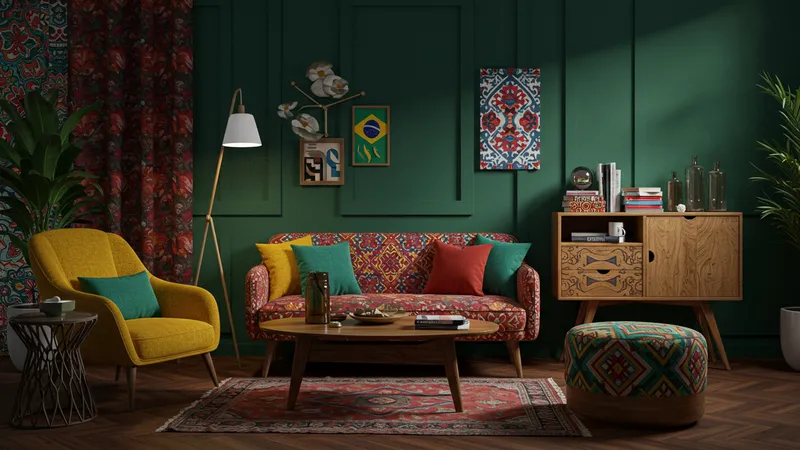
AI's ability to process vast amounts of data doesn't just spark efficiency—it identifies trends steeped in cultural relevance. Understanding local nuances, preferences, and traditional crafting techniques invites dynamic new design avenues. The confluence of AI and culture invites a wave of creativity that celebrates heritage while pushing the industry into contemporary relevance. But here lies the quandary: what to preserve, and what to innovate?
The insights generated fuel strategic expansion into new international markets, presenting Brazilian furniture design as a unique intersection of art and technology. This duality allows local craftsmen to remain both authentic and innovative, carving niches cherished worldwide. While global competition is fierce, Brazil’s approach is marked by its commitment to marrying tradition with future-forward methods in a way that stands out.
Yet, as we delve into this perfect blend of AI and culture rhythm, the story isn't over—it's constantly evolving, drawing from a deep well of innovation and cultural heritage. The narrative doesn’t just reshape the industry—it challenges it to imagine and create in new dimensions. How will emerging trends adapt, flow, and align with these cultural shifts? The impending insight will complete a cycle of tradition infused with limitless possibilities...
In the AI age, engaging consumers has redefined its rules, inviting a deeper, more interactive connection with furniture brands. Providing consumers with dynamic interfaces that enable them to co-design their furniture needs directly with manufacturers is breeding a new level of loyalty and excitement. This interactivity is more than a selling point—it's a revolution in customer relationships fueled by AI.

Consumers are no longer passive recipients; they actively partake in the creative process, guiding AI tools to predict their tastes. Customization means consumers can now visualize their dream pieces in real-time, selecting from limitless options and immediately seeing the changes AI-driven technology allows. It is reshaping the narrative of design ownership and consumer expectation. But how far this engagement can go is the next frontier to explore.
The democratization of design is unfolding unparalleled options, inspiring customers to dream boldly while maintaining grounded expectations within manufacturing capacities. AI optimizes personalization, balancing creativity with practical application—giving birth to designs that are both aesthetically appealing and technically feasible. But managing this evolved relationship introduces a new level of brand transparency, compelling companies to be more forthcoming about production practices.
This transformed dynamic has set the stage where brands must earn consumer trust through authentic dialogue and value-oriented innovation. As consumers become co-creators, the demand for high-quality, customizable pieces surges, strengthening the bond between consumer desire and brand delivery. Exploring this synergy unveils a journey of discovery poised to change not just individual experiences but the entire consumer market landscape... what revelations lie just beyond?
AI-powered waterjet technology, while powerful, does not come without its limitations. Precision and efficiency are top-notch, but complexity in design sometimes reveals AI’s boundaries. Intricate artistry still leans on the human touch—evidence that even in the age of automation, some craftsmanship cannot yet be replicated. This nuanced balance of AI capability and artistic intuition is carving out new paths in the heart of functionality and form.
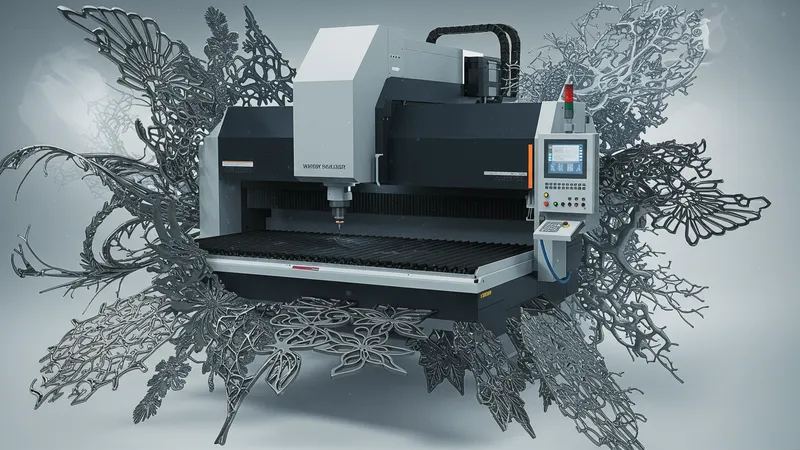
The limitation resides in overcoming unforeseen obstacles, such as system downtimes and learning inaccuracies—factors one cannot afford in a business driven by deadlines. Recognizing these limitations is crucial in enhancing designs and stabilizing operations. As AI continues to learn and adapt, companies are challenged to innovate new methods to harmonize machine capabilities with creative goals, creating unprecedented value.
However, where many view limitations, opportunity awaits. Manufacturers that can balance these intrinsic challenges will be at the forefront of a new era—leveraging AI-powered insights while maintaining high-quality craftsmanship. The continuous dialogue between artisan skills and technical expertise enriches both fields, fostering an atmosphere rich in problem-solving and imaginative approaches to traditional design challenges.
For Brazil's vibrant furniture sector, navigating through AI’s growing pains becomes a testament to resilience and innovation. Each boundary pushes the pendulum toward robust solutions that integrate sustainability, functionality, and beauty. The evolving story of AI in artisanal crafting remains an unfinished tapestry—one depicting a promising future yet lending itself to traditional roots. What change will the next wave of innovation bring?
The future of Brazilian furniture amid AI advancement is a landscape ripe for exploration. To remain relevant, manufacturers are adopting flexible technologies that adapt with consumer trends and demands. This adaptability is crucial, as it readies Brazilian industries not just to survive but to flourish in an AI-dominated reality, where digital evolution enhances the essence of physical design.
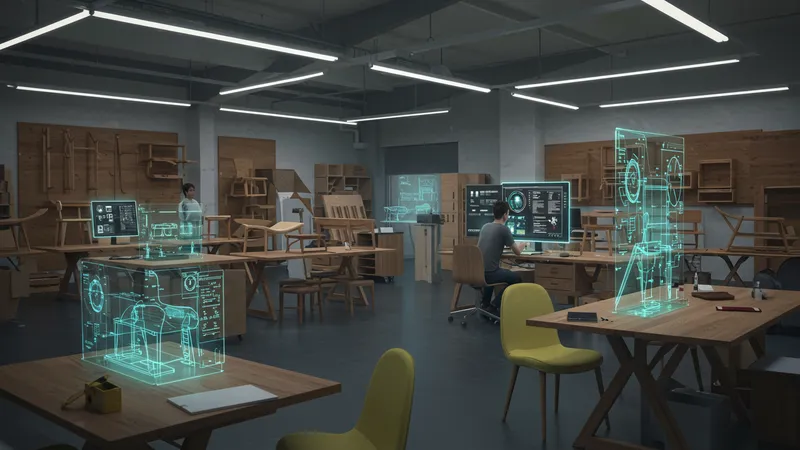
Benchmarking success means predicting market movements, designing beyond current trends, and focusing on innovation. The horizon is a fertile ground filled with possibility and creative potential, allowing local artisans to leverage AI insights for enhanced design ideations. This readiness ensures that no opportunity is left unexplored, giving Brazil a unique footing amid global innovation races.
The resilience of this industry depends on embracing change rather than fearing it. By staying informed and agile, players in the furniture space can maintain profound connections with both tradition and technology. Encouraging a culture of learning, understanding international benchmarks and expectations, firms up Brazil’s position as a go-to market for distinctive, culturally nuanced furniture.
Pragmatic adaptation offers assurance that technology will serve as an enabler, not a replacer, of the core values and rich heritage that define Brazilian craftsmanship. Yet the doorway of this evolution opens to a future where human creativity, fueled by AI advancements, shapes a vision of design that speaks volumes to the depth and diversity of its roots. The next chapter promises startling revelations waiting just around the corner...
The embrace of AI in Brazil’s custom furniture industry offers a rare opportunity to reflect on the delicate balance between tradition and innovation. While AI infuses unmatched capability into design processes, traditional craftsmanship provides a continuity of artistry and culture. The synergy between these two forces breathes new life into an industry rich in history and ripe with potential.
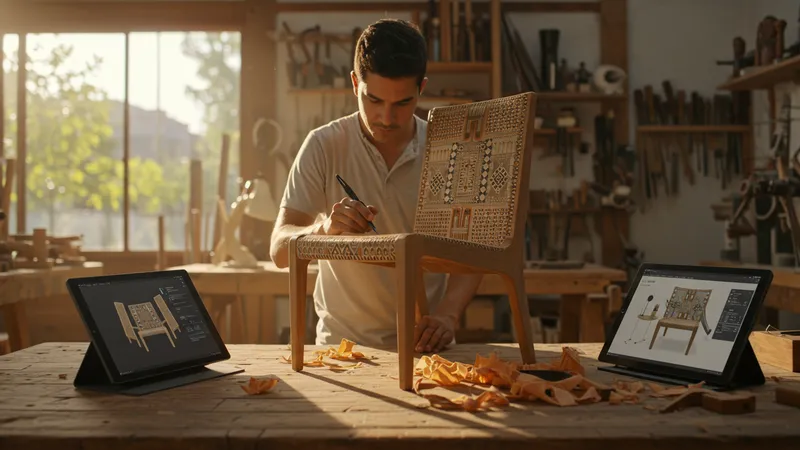
It’s a paradox—a merging of the past and future where each serves to enhance the other. Traditional techniques are not erased; they’re augmented by AI, ensuring their preservation by evolving artistry into a new age. The challenge lies in ensuring a harmonious blend where neither tradition nor technological prowess is sacrificed. The pendulum swings, creating a dance of balance with surprises at every turn.
The industry embodies this dual nature, welcoming AI’s influence on design while remaining steadfast in the essential values that have fueled furniture crafting for generations. It invites artisans and newcomers alike to envision a future where these dualities coalesce into a lifestyle of enhanced living. The narrative continues, stretching the limits of possibility to weave a story of exotic beauty interspersed with technological marvels.
For Brazil, the heart of vibrant design culture now beats to a technologically enhanced rhythm. Yet with every advancement comes the choice of how much and which paths to pursue. The future is promising, paved by intentional decisions today that monk timeless tradition with world-class innovation tomorrow. What uncharted territories will AI help us explore next in this creatively odyssey?
Brazil’s fusion of AI with custom furniture design is more than a national story—it’s a beacon for the world. This innovation not only reflects the country’s adaptability but positions it as a key player on the global stage. As these tailored designs traverse continents, they bring with them the rich cultural tapestry of Brazilian heritage, making a compelling case for craftsmanship worldwide.

AI empowers designers to strike the balance between creativity and precision, capturing hearts across borders and showcasing Brazil's distinctive aesthetic flair. The reach is colossal—allowing local designs to echo in international marketplaces previously unreachable. This reach strengthens Brazil’s status as a leader in culturally driven design stories that captivate and inspire audiences globally.
Internationally, the appetite for exotic, innovative, and finicky crafted pieces is growing. With AI advancements, Brazilian designers stand ready to meet that demand by providing unparalleled quality, creativity, and depth. It’s a narrative framed by technology, yet deeply rooted in culture, beckoning newfound respect and recognition from global industry leaders.
The curtain is not closing—instead, it’s revealing a larger stage where Brazilian craftsmanship, invigorated by AI, steps into the limelight. The global industry watches as Brazil implores what’s next, guiding the tides of craftsmanship with a promise of groundbreaking revelations that shape art as we know it. The journey of innovation and exploration is poised to continue, bringing untold stories to the fore...
Art and technology don't just coexist in Brazil’s custom furniture industry—they ignite a transformation process that redefines boundaries. Together, they unfold narratives that speak the language of innovation and tradition. Brazilian artisans, using AI-powered waterjet technology, aren’t just creating furniture; they’re crafting unprecedented stories told through each piece.
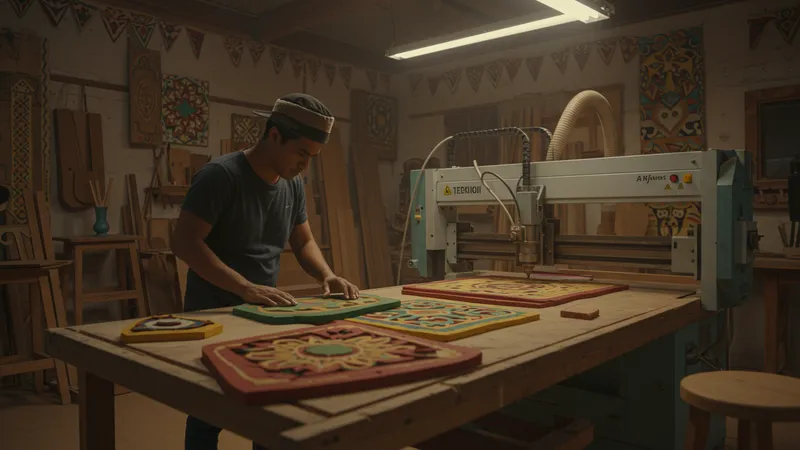
This transformation isn’t superficial; it penetrates the essence of design itself. Every piece crafted tells a story of technical finesse married with cultural authenticity, inviting users to become part of a grander narrative that reflects individuality and shared heritage. The furniture gains a voice, resonating with global audiences who yearn for depth and expression.
AI lends an ear to this expressive force, turning data into beauty, but with every advance in technological capability comes an expansion in artistic grasp. This dual advancement catalyzes new frontiers, energizing the industry to reach for heights previously unimaginable. As transitions blur the lines between art and tool, every creation becomes a testament to the journey through the fusion of function and form.
The excitement lies ahead—an odyssey of creativity marked by unexpected turns and breathtaking opportunities. Brazil stands at this crossroads with a wealth of creativity and technology poised to redefine the very landscape of design. Here, art thrives, driven by tech, with stories in every curve, awaiting discovery... what revelation will this journey present next?
The evolution of AI technology in furniture crafting is akin to a wave—a momentum that’s unstoppable and continually redefines what’s possible. As Brazilian artisans and manufacturers ride this wave, they transform challenges into opportunities, harnessing the power of AI to unleash a new creative frontier. This wave isn’t restrictive—it’s liberating, revealing possibilities that were once confined to dreams.
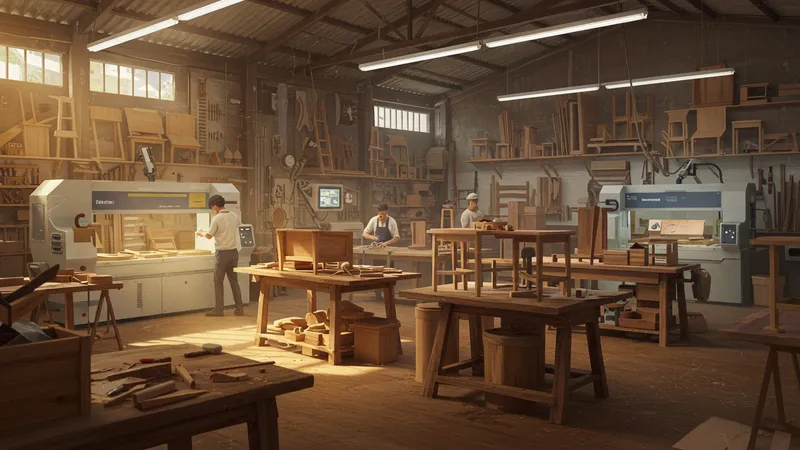
AI's role in empowering design processes continues to unfold, offering precision and sustainability hand-in-hand. The imaginative freedom allowed by AI drives a reimagining of design, celebrating the seamless convergence of technology and artistry. At the heart of this metamorphosis is a vision—one that rekindles legacy while advancing modern-day marvels at an electrifying pace.
The wave of innovation stirs excitement, challenging traditional boundaries while making way for emergent trends and ideas. Those riding the wave aren’t merely observers—they’re creators, reshaping traditions with a blend of awe and expertise. It’s a lively dance of innovation, and every new dawn casts Brazil in the spotlight, solidifying its reputation as a crucible of design ingenuity on a global stage.
As this story unfolds, each revelation promises not just innovation but reinvention, with twists that continue to invite curiosity and admiration from around the world. The wave doesn’t end—it carries the promise of future explorations steeped in creativity, inviting more enthusiasts to revel in the journey that keeps on unfolding. What the future holds remains as exciting as the past triumphs, forever beckoning deeper into the voyage...
The vivid convergence of AI technology in Brazil's furniture industry isn’t just rewriting the rules—it's creating an uncharted map of opportunities limitless in potential. The takeaway? This journey of innovation is a collective dance, harmonizing tradition with the latest tech advances, nurturing a future of unbridled creativity and cultural expression. As this story of transformation echoes the world over, the call is for everyone involved to embrace, explore, and excel beyond boundaries. Share this insightful journey, bookmark it for further reflection, and take part in shaping the story of tomorrow. The journey of AI-powered artistry has only just begun, and its unfolding tale—one of endless potential and vibrant evolution—is set to unveil wonders still unseen.